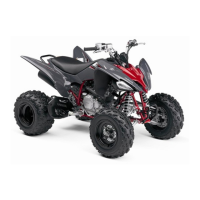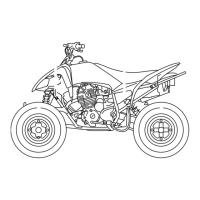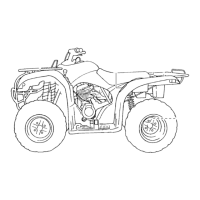Do you have a question about the Yamaha YFM250R-W and is the answer not in the manual?
Essential safety guidelines for operating the ATV safely and preventing accidents.
Identifies key components visible from the left side of the ATV.
Identifies key components visible from the right side of the ATV.
Details the location and identification of the ATV's primary controls and instruments.
Explains the main switch operation and the function of dashboard indicator lights.
Details operation of handlebar switches, throttle, speed limiter, clutch, and brake levers.
Operation and adjustment of front/rear brake levers, brake pedal, and parking brake.
Covers fuel cap, fuel cock, starter (choke), and steering lock functions.
Procedures for seat removal/installation and adjusting front/rear shock absorber settings.
Ensuring adequate fuel and engine oil levels before operating the ATV.
Verifying front/rear brake operation, fluid levels, and checking for leaks.
Checking tire pressure, wear limits, and overall tire condition.
Checking drive chain, clutch, cables, and chassis fasteners before riding.
Step-by-step guide for starting the engine, including choke usage for cold starts.
Procedures for moving off, accelerating, and shifting through the gears.
Guidelines for new engine break-in and proper parking procedures.
Familiarizing with controls, safety apparel, age limits, and avoiding hazards.
Guidance for riding on unpaved, rough, or slippery surfaces and handling sliding.
Techniques for turning, climbing, descending hills, and crossing shallow water.
What to do if the ATV doesn't turn, tips for uphill/sideways slides, and water hazards.
Periodic maintenance schedules for emission control and general vehicle systems.
Procedures for spark plugs, oil, air filter, spark arrester, carburetor, and throttle cable.
Checking and adjusting brake pads, fluid, levers, pedals, and parking brake.
Maintenance for drive chain, cables, levers, pivots, and steering shaft.
Procedures for battery, fuses, bulbs, and wheel removal/installation.
Diagnosing and resolving common engine starting and operational problems.
Detailed steps for cleaning the ATV to maintain appearance and performance.
Instructions for short-term and long-term storage to protect the ATV.
Key physical dimensions, wheelbase, ground clearance, and overall weight.
Specifications for engine type, displacement, and transmission gear ratios.
Information on tire size, pressure, wheel type, and brake system details.
Specifications for lights, battery, ignition, charging system, and fuses.
Recording key, vehicle, and model identification numbers for reference.
| Brand | Yamaha |
|---|---|
| Model | YFM250R-W |
| Category | Offroad Vehicle |
| Language | English |









